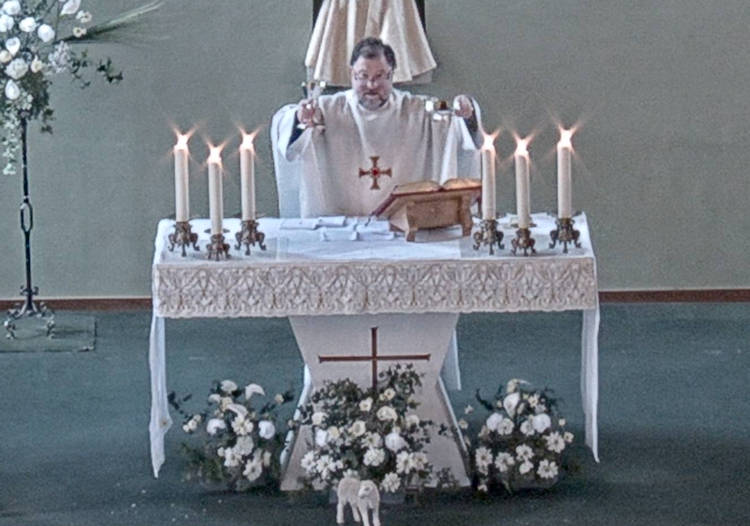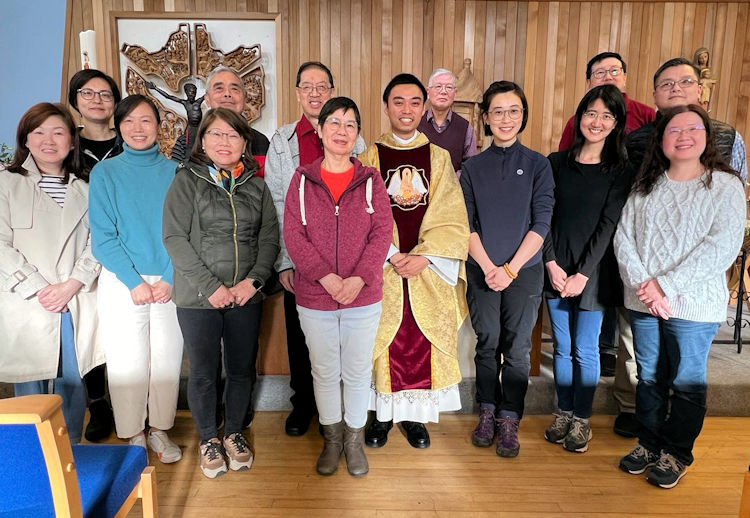Cambridge church ahead of game with live-streaming

East Anglia paddle to raise funds for leprosy centre
June 26, 2020
As churches re-open Rebecca tells us how to stay safe
June 29, 2020St Laurence’s in Cambridge was well ahead of the game and began live-streaming Masses a whole year before lockdown began. One of the system’s creators, Sean Martin, shares some of their reflections on how to get the best out of it.
We started live streaming from St Laurence’s in Cambridge in March 2019, after initial testing and feedback from a very helpful pilot group of parishioners, and it is interesting to reflect on our experiences to date.
We started with the objective of allowing the housebound of the parish to continue to participate at Mass – little did we realise then that would apply to all of us in this recent period of lockdown.
We considered options and focused on a “keep it simple” approach, as reliable and sustainable as possible, and we also sought to minimise regular activities, such as might require a rota, or to keep a schedule up to date. These have all turned out to be the case – the approach we use requires only a camera with streaming software, and network wiring to connect it to broadband. There is no need for an additional PC or laptop, and we are alerted if streaming has stopped.
Since we started we have had no issues with the camera, and any failures have been caused by broadband or electricity supply interruptions. It has been sufficiently reliable that one almost forgets that Mass is being streamed – it does not detract from the experience of the congregation, or the celebrant.
Of course, lockdown caused changes. But, fortunately our priests Fr Simon and Fr Bob could continue to say Mass in a largely similar manner as before, but with an empty church. However, we now prepare a CD that can be played during Sunday Mass with readings, singing and music, and this is, of course, streamed as would normally happen.
A sheet with the hymns and sung responses, a link to the day’s readings, and the Spiritual Communion Prayer of St Alphonsus is included on the parish website (in common PDF format), and announced via CD at the beginning of Mass. We have also learned that it can be helpful for the celebrant or reader to look occasionally to the camera, for example, for the sign of peace or when using the thurible with incense.
Around the start of lockdown the Diocese of Leeds helpfully published their reflections on live streaming, where some pertinent points included:
- The Holy See encouraged live and not recorded streaming.
- The streaming should be as authentic as possible: it should not try to imitate a TV broadcast, as it is not an entertainment programme. It should emphasise Sacrifice not Spectacle.
- The camera Is placed for the best “congregant’s eye view” of Mass, and the view is framed to the Sanctuary, avoiding viewing empty pews, and the view is static.
We found we were reading a written explanation of what, perhaps, we had accidently sought to do, as that largely describes the approach we took for our live streaming.
Not long after lockdown began, the Anglican Provost of Sunderland Minster, Ven Stuart Bain tweeted “To my fellow broadcasters: God loves good audio more than good video.” That resonated, as we had sought really hard to stream good audio, and had many positive comments as a result.
Our SVP group are in touch with those who would be housebound in normal times, and we asked parishioners to donate any laptops that were no longer in regular use. We reconditioned these and have made them available through the SVP for the housebound so they could view streamed Mass.
Given that such a person is likely to have limited experience of using a laptop, we tried to make these as easy to use as possible. After switching on, it starts at the web page ready to start streaming, so as to minimise what needs to be done. Even so, this was with mixed success. This is why we are now exploring making recordings that can be taken on a USB device by an SVP member to the housebound, and then played so that they can “see Mass”, in a similar way to how audio recordings from Mass used previously to be taken to the housebound.
Our camera streams continuously to YouTube, except for rare occasions, such as a concert. We are familiar with the copyright issues, and have obtained two licences, which we considered necessary for streaming.
The camera allows one to define “rectangles” within the overall field of view as seen by the camera. This is how we crop down the view to the Sanctuary so that only that is streamed. This regular Sanctuary view is for Masses, Weddings and Funerals. However, as this view does not include the font, we have a separate stream that includes the font for Baptisms.
Since Easter we have a close-up view of the altar, which was helpful for the Veneration of the Cross on Good Friday, and is now used for regular periods of Exposition. We also have a silent meditative stream for private prayer focused on the Crucifix and Tabernacle. We thus allow the congregant to choose the stream best suited for their current purpose, from a choice of four streams on the parish website. Hence we do not need to change any settings on a regular basis, and as streaming is continuous, we do not need to maintain a schedule of when it is live.
The camera does allow us to easily change the view of a running live stream. We have conducted trials with zoom-in views, and perhaps surprisingly, received quite a luke-warm response. However, there could be a simple explanation – people are used to sitting in the same seat throughout Mass, except for Communion, and thus a static view is what congregants normally have, and thus expect. Indeed, too many changes, and especially rapid changes, of view were considered distracting. Hence the use of multiple views, such as close-ups, should be used only sparingly.
We considered three such opportunities during Mass: the Consecration through to the sign of peace, the readings and the homily. However, the latter two are largely aural experiences, and indeed could be fully experienced with closed eyes, hence a close-up view seems unnecessary. Hence we intend to explore switching to a close-up view of the altar during the Consecration. This can be achieved by two button clicks or view changes during a Mass from within the church or from home. However, given this was deemed to be of marginal benefit, if this is adopted, it is likely to be only on an ad-hoc manner without a rota.
The camera we have used can work in small through to very large churches, since a telephoto lens can be fitted to the camera, so that there is still good coverage of the Sanctuary even from a distance. With the relaxation of lockdown restrictions we are now installing in a nearby church. The average cost is around £1,300 – a telephoto lens would be additional. The only recurrent monthly cost has been for broadband, which in both cases had already been installed.
To conclude, here is some appreciative feedback we have received: “I have just ‘attended’ your live streamed Mass, which I came across while searching for a Vigil Mass this evening. I felt I must write and thank you as I was so moved by the service. I have watched services every week since the lockdown began but, until tonight, I felt very much an observer. Tonight, with the singing, sign of peace, readings (I assume) by parishioners I was actually moved to tears. I felt as if I were actually celebrating Mass with others for the first time. Thank you all so much for the experience. I will be joining you again next week. Sue from Somerset.”
If you are interested in exploring this further, or in comparing notes with your streaming strategy and experiences, we would be glad to hear from you – you can contact us at techgroup@saintlaurence.org.uk
Pictured above, Fr Simon Blakesley celebrates a live-streamed Mass at St Laurence’s.




